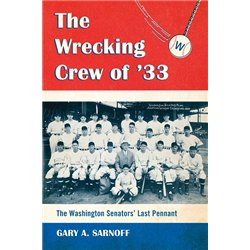Part 3
Buddy Myer was anything but calm when he arrived in the Senators clubhouse on the morning of October 3rd.  Washington’s star second baseman was taxiing to the Polo Grounds when he saw a pedestrian walk into the path of his vehicle. The man was able to dodge the cab, but stepped before of a truck going the opposite direction, which dashed him into a steel structure of an elevated railroad, killing him instantly. With Game One just two hours away, Myer’s thoughts were on the tragedy instead of the game.
Washington’s star second baseman was taxiing to the Polo Grounds when he saw a pedestrian walk into the path of his vehicle. The man was able to dodge the cab, but stepped before of a truck going the opposite direction, which dashed him into a steel structure of an elevated railroad, killing him instantly. With Game One just two hours away, Myer’s thoughts were on the tragedy instead of the game.
Joe Cronin had kept quiet about his pitching choice for the first game of the World Series. The mystery was solved when the sportswriters saw Lefty Stewart on the field while General Crowder and Earl Whitehill, Washington’s two twenty-game winners in 1933, were in the dugout.
Carl Hubbell and the Giants took the field and faced the flag for a rare playing of the National Anthem, which was only played during World Series games back then. As the band played, Hubbell became emotional to the point where tears began to stream down his cheeks. “I had all kinds of things running up and down my spine,” he would say later, meaning he was inspired to pitch a great game.
Buddy Myer stepped in as game’s first batter. With a 2-2 count, he fouled off a few pitches before taking a called third strike. Myer did not like the call, and he let National League umpire Charles Moran know that he disagreed.”
Goose Goslin was up next. He took ball one before looking at two screwballs for strikes, and then he swung and missed to become Hubbell’s second strikeout victim. After Manush went down swinging, Carl Hubbell had struck out the side in his first every World Series inning.
Lefty Stewart knew he would have to be on his game today to match his counterpart. He got the first batter to hit one on the ground, but Myer booted the ball for an error. It was one of three fielding miscues he would have on the day.
After the next two batters made outs, Mel Ott hit a home run in his first ever post season at bat to give New York a 2-0 lead.
In the bottom of the third, the Gants tacked on two more for a 4-0 lead to send Stewart to the showers. The Senators finally broke through for a run in the forth inning when Myer singled, moved up two bases on an out and an error, and scored on a fielder’s choice.
Washington, still trailing, 4-1, had one more chance in their half of the ninth. An error, Cronin’s second hit, and an infield hit by Fred Schulte loaded the bases with nobody out. “A homer will do it!” yelled a Washington fan as Joe Kuhel steeped in, which had to make Giants manager Bill Terry nervous. He had warned his pitchers to be extra careful when pitching to him.
Hubbell induced Kuhel to hit one on the ground for a fielder’s choice. A run scored to make it a two-run game. There was only one out with runners on first and third for Ossie Bluege, however, the Senators third baseman could not touch Hubbell’s screwball. A swing and a miss for strike three was the second out of the inning.
Luke Sewell grounded to the third baseman, who threw across the diamond to Terry at first base to end the game. The New York manager tossed the ball to Hubbell, a souvenir for a well pitched game.
In the clubhouse following the game, Myer began to talk about the accident he had witnessed. The last thing he wanted to talk about was Game One.
Gary is the author of The Wrecking Crew of ’33; The Washington Senators’ Last Pennant.






